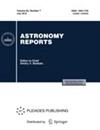Gaia DR3纪元中的分光双仙女座AU Peg:椭球度、质量和演化状态的影响
摘要
对通常归类为BL - Her的造父变星AU - Peg的物理特征和演化状态进行了修正。考虑到以前未公布的径向速度测量,用径向速度计(RVM),对造父变星及其伴星的相对轨道参数进行了改进。根据现有的径向速度测量和光度观测,对造父变星的脉动半径进行了一些估计。基于在JD2453930-2459490期间与盖亚DR3光度观测几乎同时进行的74次新径向速度测量(JD256962-2457877期间的44次亮度测量),采用脉动光球法确定AU Peg的平均半径为(16.0±0.6)\({{R}_{ \odot }}\);半径变化幅度约为0.7 \({{R}_{ \odot }}\)。第一次,2% brightness variations are found for a spectroscopic binary Cepheid in the G band with a half orbital period, the phases of which are clearly synchronized with the phases of the orbital motion (conjunctions and quadratures) and can be interpreted as a manifestation of the ellipsoidality effect of the main component filling the Roche sphere at 60–70%. The orbit of the binary system calculated on the basis of astrometric data from Gaia DR3 and radial velocities is limited by a torus with a thickness of |z| ≤ 300 pc and inner and outer radii equal to 7.2 and 8.8 kpc, respectively, while the vertical velocity lies within |Vz| ≤ 18 km/s. Based on the kinematics and abundance of heavy elements, AU Peg can certainly be classified as a representative of the typical population of a thin disk of moderate (∼1–3 Gyr) age, which completely excludes its classification as a BL Her variable. The Cepheid, which current mass, as follows from the magnitude of ellipsoidality, does not exceed ∼(0.85 ± 0.05) \({{M}_{ \odot }}\), is at the evolutionary stage after the mass exchange in the subgiant phase with a companion - a main-sequence star, which is currently significantly more massive than the Cepheid.

The physical characteristics and evolutionary status of the spectroscopic binary Cepheid AU Peg, usually classified as a BL Her variable, is revised. Taking into account previously unpublished radial velocity measurements made with a radial velocity meter (RVM), the parameters of the relative orbit of the Cepheid and its companion are refined. Based on the available radial velocity measurements and photometric observations, a number of estimates of the Cepheid’s pulsating radius are made. Based on 74 new radial velocity measurements made in the period JD2453930–2459490 virtually simultaneously with the Gaia DR3 photometric observations (44 brightness measurements in the period JD256962–2457877), the mean radius of AU Peg is determined by the pulsating photosphere method equal to (16.0 ± 0.6) \({{R}_{ \odot }}\); the amplitude of radius variations is about 0.7 \({{R}_{ \odot }}\). For the first time, 2% brightness variations are found for a spectroscopic binary Cepheid in the G band with a half orbital period, the phases of which are clearly synchronized with the phases of the orbital motion (conjunctions and quadratures) and can be interpreted as a manifestation of the ellipsoidality effect of the main component filling the Roche sphere at 60–70%. The orbit of the binary system calculated on the basis of astrometric data from Gaia DR3 and radial velocities is limited by a torus with a thickness of |z| ≤ 300 pc and inner and outer radii equal to 7.2 and 8.8 kpc, respectively, while the vertical velocity lies within |Vz| ≤ 18 km/s. Based on the kinematics and abundance of heavy elements, AU Peg can certainly be classified as a representative of the typical population of a thin disk of moderate (∼1–3 Gyr) age, which completely excludes its classification as a BL Her variable. The Cepheid, which current mass, as follows from the magnitude of ellipsoidality, does not exceed ∼(0.85 ± 0.05) \({{M}_{ \odot }}\), is at the evolutionary stage after the mass exchange in the subgiant phase with a companion - a main-sequence star, which is currently significantly more massive than the Cepheid.

 求助内容:
求助内容: 应助结果提醒方式:
应助结果提醒方式:


